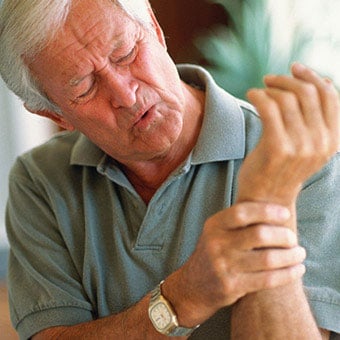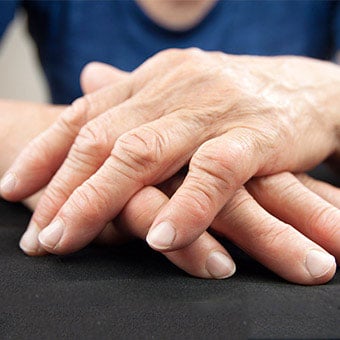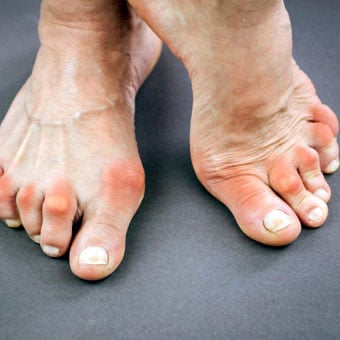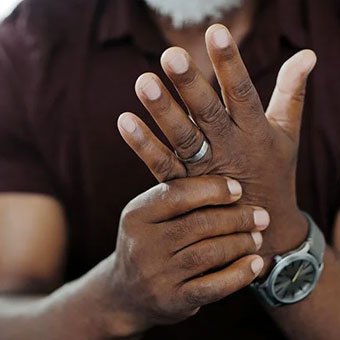16 Early Rheumatoid Arthritis (RA) Signs & Symptoms
- What Is RA?
- 16 Early RA Signs & Symptoms
- Fatigue
- Joint Problems
- Polyarthritis
- Limping
- Symmetry
- Anemia
- Fever
- Depression
- Other Forms of RA
- Doctor's Perspective

What is rheumatoid arthritis (RA)?
Rheumatoid arthritis (RA) is a type of inflammatory arthritis and autoimmune disease.
- RA disease is characterized by chronic joint inflammation.
- Rheumatoid arthritis in the knee, hands, fingers, and feet is common.
- RA may also be called rheumatoid disease because at times rheumatoid arthritis causes systemic illness that impacts many organs of the body.
- Chronic inflammation of RA can cause permanent joint destruction and deformity.

What are early signs and symptoms of rheumatoid arthritis (RA)?
While early signs and symptoms of RA can be mimicked by other diseases, the warning signs and symptoms are very characteristic of rheumatoid disease. The 16 early RA symptoms and signs discussed in this article include the following:
- Fatigue
- Joint pain
- Joint tenderness
- Joint swelling
- Joint redness
- Joint warmth
- Joint stiffness
- Loss of joint range of motion
- Many joints affected (polyarthritis)
- Limping
- Joint deformity
- Both sides of the body affected (symmetric)
- Loss of joint function
- Anemia
- Fever
- Depression
Fatigue
Fatigue is a very common symptom in all stages of rheumatoid arthritis, particularly when the joint inflammation is active. Fatigue in rheumatoid arthritis can be caused by the body's reaction to inflammation, poor sleep, anemia, and medications.
The fatigue of rheumatoid arthritis that results in a lack of energy can adversely affect emotions and mood, occupation, relationships with people, sex drive, productivity, attentiveness, creativity, and happiness.
- Fatigue from rheumatoid arthritis can also be associated with other symptoms and signs, such as poor appetite and weight loss.
Joint pain
Joint pain from rheumatoid arthritis is caused by the inflammation present in a joint when the disease is active. Joint pain can also occur when the disease is inactive or controlled if the joint has been damaged by rheumatoid arthritis in the past.
Active rheumatoid arthritis flare-ups cause the joint to swell because of both thickenings of the joint lining tissue (synovium) and because of excess joint fluid. The swollen inflamed joint stretches and irritates the capsule that surrounds the joint. The joint capsule has nerve endings within it that immediately send pain signals to the brain.
Past rheumatoid arthritis can lead to permanent joint destruction with damaged cartilage, bone, and ligaments. When the damaged joint is used, it can cause intense pain.

Joint tenderness
Rheumatoid arthritis characteristically leads to the tenderness of the involved joints. This is because the inflamed joint lining tissue has irritated the nerves in the joint capsule. When the irritated joint capsule is compressed by external pressure, such as from touching the joint, it is frequently tender.
- The pain elicited from compression is immediate.
- This is one of the reasons that rheumatoid arthritis can lead to difficulty sleeping and insomnia.
Joint swelling
Swollen joints are very common in rheumatoid arthritis. Sometimes the joint swelling is minimal and can be difficult to appreciate. Other times the joint swelling is very apparent. Generally, people who are affected by rheumatoid arthritis can easily tell when their joints are swollen.
- The joint swelling can lead to loss of range of motion of the joint.
- Joint swelling in the fingers can make it hard to get rings off and on easily.
Joint redness
Redness occurs over joints when they are inflamed. The redness in the skin over an inflamed joint from rheumatoid arthritis occurs because the capillaries of that skin are widened by the adjacent inflammation. These widened capillaries are referred to as dilated capillaries.
- Joint redness does not occur in all inflamed joints from rheumatoid arthritis.
- Sometimes the inflammation in the joint is inadequate to cause the capillaries in the skin to dilate.
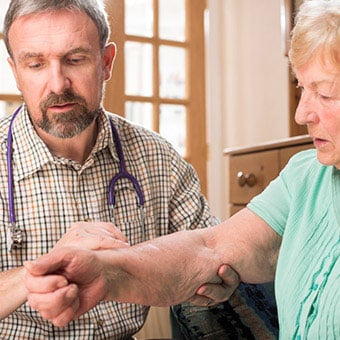
Joint warmth
The warmth of the joints affected by rheumatoid arthritis is a sign of active inflammation. Doctors look for joint warmth as they monitor the activity of the disease. As rheumatoid arthritis responds to treatment, joint warmth resolves.
- Sometimes joint warmth is present without visible joint swelling or redness.

Joint stiffness
Stiffness is a typical rheumatoid arthritis symptom. Joints that are affected by active rheumatoid arthritis are inflamed and characteristically stiffer in the morning than later in the day. Doctors use the duration of the morning stiffness as a measure of the severity of the active joint inflammation.
- As rheumatoid arthritis responds to treatment, the duration of the morning joint stiffness diminishes.
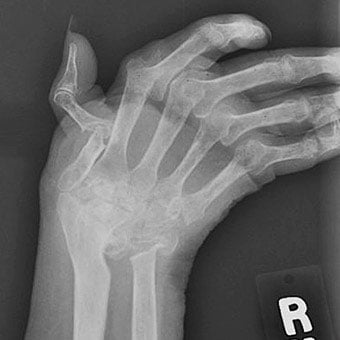
Joint deformity
Joint deformity can occur from chronic rheumatoid arthritis. Deformity in rheumatoid arthritis occurs because the unchecked inflammation leads to erosions of cartilage and bone as well as ligament loosening (laxity).
- Early diagnosis and treatment of rheumatoid arthritis are critical to prevent permanent joint damage and joint deformity.
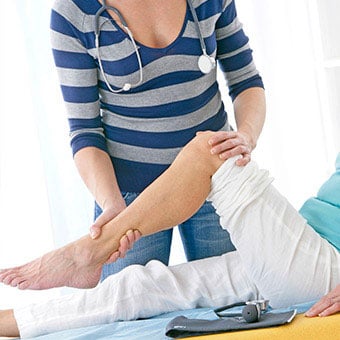
Loss of joint range of motion
As the joints of rheumatoid arthritis become more inflamed with active disease, they tend to have an incomplete range of motion. The range of motion is limited by the swelling within the joint. This is typically associated with weakness in the involved areas.
- Joints affected by longstanding rheumatoid arthritis commonly lose range of motion permanently.

Many joints affected (polyarthritis)
Usually, but not always, rheumatoid arthritis affects many joints. Classically, RA affects the small joints of the hands and wrists and balls of the feet. Also, not uncommonly, knees, elbows, hips, ankles, and shoulders can be inflamed.
- Sometimes, only a few joints are involved. Less frequently, a singular joint is involved. Both of these scenarios are more common in childhood inflammatory arthritis (juvenile rheumatoid arthritis).
- When four or more joints are inflamed, the condition is referred to as polyarthritis. When only a few joints are inflamed, it is referred to as oligoarthritis. When a single joint is inflamed, it is referred to as monoarthritis.

Limping
Limping from poor lower extremity function can be caused by many diseases of the nerves, muscles, and bones of the lower extremities. Limping frequently occurs when rheumatoid arthritis affects the hips, knees, ankles, or feet.
- Pain, loss of range of motion, and joint swelling all can cause a person with rheumatoid arthritis to have a noticeable limp.
- It is not unusual for a young child with rheumatoid arthritis to have a painless limp as the first sign of rheumatoid disease.

Both sides of the body affected (symmetric)
Typically, the distribution of the joints involved in a person with rheumatoid arthritis is similar on both sides of the body. This symmetric joint involvement is a feature of classic rheumatoid arthritis. This does not mean that joint involvement is always symmetric, but it is common.
Rheumatoid arthritis usually (not always) involves many joints on both sides of the body. It is, therefore, sometimes referred to as an asymmetric polyarticular form of arthritis.
- Accordingly, the small joints of the hands, wrists, and feet are commonly affected.
- The knees, ankles, shoulders, hips, and elbows can also be involved in early disease.
- Rheumatoid arthritis is characterized by inflammation in these joints.
- Early manifestations of this inflammation can be gradual or rapidly intense.
- The joint inflammation causes stiffness, usually worse in the morning or after being sedentary.
- It also causes warmth, swelling, redness, and pain in varying degrees.
- The joint can be very subtly affected with slight swelling or markedly affected with substantial loss of range of motion.
- The pain level can be completely disabling and does not always correlate with the degree of apparent inflammation.
As described above, the manner that each of the symptoms affects an individual can be very different from individual to individual and can vary during the day. The intensity and effect of each of the symptoms are dependent upon the RA patient's age, activity, the medications he or she takes, as well as any additional medical conditions that are present.

Loss of joint function
Because rheumatoid arthritis leads to pain, swelling, and tenderness of the involved joints, there is the loss of joint function. The swelling and sensitivity impede the full motion and stability of the joint and it becomes incapable of carrying the movement with confidence, balance, and completeness.
- This loss of joint function leads to limping, lack of coordination, loss of grip and dexterity, and disability.
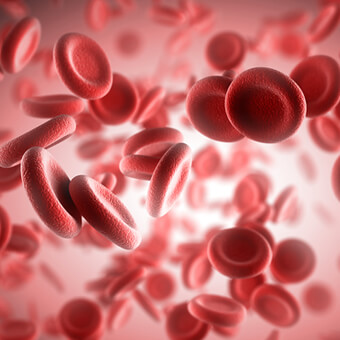
Anemia
The chronic inflammation of rheumatoid arthritis commonly causes the bone marrow to decrease the release of red blood cells into the circulation. This lowers the red blood count to cause anemia when rheumatoid arthritis is active. It is not unusual for the anemia of rheumatoid arthritis to spontaneously correct as the inflammation of the disease is quieted by treatment.

Fever
Fever, while not common in rheumatoid arthritis, does occur in some patients when the disease is actively causing inflammation. Typically, there is only mild low-grade temperature elevation and this corrects rapidly as the inflammation of rheumatoid arthritis is treated.
Because patients with rheumatoid arthritis frequently require medications that can decrease the normal immune response, it is important that when they develop fever, infection is considered as a possible cause.
- Infections can require aggressive treatment and interruption of some underlying rheumatoid treatments.

Depression
Because rheumatoid arthritis is a chronic condition potentially associated with pain and disability, it can lead to depression. A person with rheumatoid arthritis can commonly feel frustrated, but it can also lead to real depression with sadness, hopelessness, and a blue mood that goes beyond frustration. Doctors refer to this form of mood change as "reactive depression" because it is a person's response to a particular situation, in this case, a new chronic disease.
- When patients feel depressed, regardless of cause, it is essential to share their feelings with their healthcare provider.
- Over time, this can lead to a much healthier understanding of their bodies and improvement and resolution of their depression.

What are the less common forms of rheumatoid arthritis?
Rheumatoid arthritis can begin in less common forms. For example, it can begin with the involvement of only a single joint or a few joints. Sometimes, this can later evolve to the more common presentation of many joints on both sides of the body.
- Rarely, the earliest symptom of rheumatoid disease is inflammation of a body area that does not even involve a joint. For example, the lining of the lungs (pleura) can become inflamed to cause pleurisy many months before arthritis develops.
- Occasionally, only a few joints are involved and the doctor may suspect another type of inflammatory arthritis. (There are over 100 forms of arthritis!) Again, this can sometimes only later evolve to become the more typical symmetrical polyarthritis by including many joints on both sides of the body.
- The caveat is that by recognizing the early symptoms of rheumatoid arthritis rheumatologists and their patients can address the disease early, thereby affording optimal outcomes for those affected.
12 Early Signs of Arthritis in Hands
A joint is the area where two bones meet. Within joints is a tissue called cartilage that acts as a cushion between two bony surfaces. Synovial fluid within joints protects them and helps facilitate movement. Synovial fluid is secreted by the inner lining of the joint called the synovial membrane. Hand arthritis occurs when there is inflammation in one or more joints of the hand and wrist. There are over 100 types of arthritis. A few of the common types of arthritis that affect the hands are osteoarthritis, rheumatoid arthritis, post-traumatic arthritis (arthritis as a result of an injury), psoriatic arthritis and gout. The two most common types of arthritis that affect the hands are osteoarthritis and rheumatoid arthritis. Hand osteoarthritis occurs when there is wear and tear of one or more joints of the hand as seen with increasing age. Rheumatoid arthritis occurs when the body’s immune system attacks the joints of the hand.

14 Early Signs of Arthritis in the Legs
The term arthritis refers to redness and swelling of the joints characterized by joint pain and stiffness. A joint is the area where two bones meet. The two bones at the site of the joint are separated by a cushioning tissue called the cartilage that protects the joint and facilitates proper movement. The joint space is lined by the synovial membrane that secretes a fluid called synovial fluid. Synovial fluid lubricates and protects the joints to allow for adequate movement. Arthritis may result when any of the joint structures are damaged. Leg arthritis affects the joints of the hips, knees, ankles, or feet. There are over 100 types of arthritis. The most common types of arthritis affecting the legs are
- Osteoarthritis: This is the most common type of arthritis. It occurs due to wear and tear of the joint cartilage that happens with increasing age.
- Rheumatoid arthritis: In this type of arthritis, the body’s immune system attacks and damages the joints.
- Gout: This occurs due to excessive deposition of uric acid crystals in the joints, which causes joint inflammation.
- Septic arthritis: This refers to arthritis that occurs as a result of joint infection.
- Post-traumatic arthritis: This type of arthritis results because of injury or after a surgery or other invasive procedure on the joint.
- Psoriatic arthritis: People who suffer from a long-term skin condition, psoriasis, may develop psoriatic arthritis along with the skin manifestations such as plaques.


